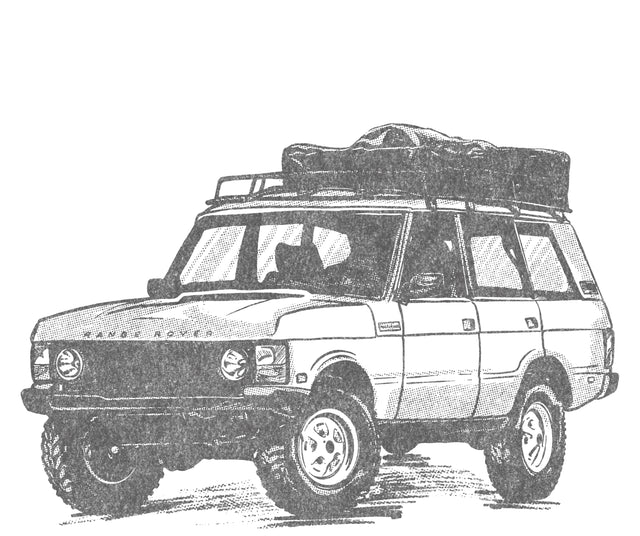Land Rover Range Rover Classic
A car for all reasons - Land Rover introduced the Range Rover Classic in June 1970 as its initial entry into the emerging sport-utility market. One of the early 4x4 mid-size Sport utility vehicles on the market, the Range Rover Classic, enjoyed a production run from 1969 to 1996.
It became the first-generation vehicle to launch the new Range Rover name, facilitating the company’s brand transition from the Rover division of British Leyland (later Land Rover) to the Rover Group. The company marketed it as "A Car for All Reasons."
The original Range Rover was built as a two-door model, adding a four-door option in 1981. The two-door version remained available until 1994, the year the second-generation Range Rover was launched. At that time, Land Rover rebranded the original Range Rover as the "Range Rover Classic" to distinguish it from its P38A successor and applied the name retrospectively to all first-generation Range Rovers.
Genesis of the Range Rover Classic
By the mid-1960s, Rover recognized the early potential of the emerging SUV market in North America. In 1967, under Charles Spencer King, Rover began the "100-inch Station Wagon" program to compete with the likes of prototype SUVs such as the International Harvester Scout (1961) and the Ford Bronco (1966).
In the effort to shift the rugged 4x4 model towards speed and comfort while retaining off-road ability, the president of the company's USA operations shipped a Land Rover Series II 88 to Britain fitted with an advanced small block all-aluminum Buick V8 engine.
While driving a Rover P6 across an area of rough scrubland on the Solihull factory site, King recognized a need for the sort of long-travel coil spring suspension found in the Ford Bronco to achieve the desired blend of luxury car comfort and Land Rover's proven off-road ability. He also became convinced that a permanent four-wheel drive transmission would provide better handling and reliably absorb the power necessary to be competitive in the market. The final bodywork featured a design largely done by the engineering team in a departure from designs created through David Bache's styling division.
Range Rover received wide critical acclaim for building a car that was arguably better than any other four-wheel-drive vehicle at the time in being equally capable both on and off-road.
A Standout in its Class
Range Rover gave the early model Classic a model designation known as "suffix," referring to the last character of the VIN, beginning with Suffix A and going in succession as the vehicles came off the assembly line.
The Range Rover Classic reached a top speed of 95 mph (153 km/h) and could accelerate from a standstill to 60 mph (97 km/h) in less than 15 seconds, making it a standout in performance against similar cars of its era. The 1995 Classic had an improved top speed of approximately 110 mph (180 km/h) and a reduced acceleration time of around 11 seconds to go from 0 to 60 mph (0 to 97 km/h).
Additionally, it had a towing capacity of 3.5 tons, hydraulic disc brakes on all wheels, and a four-speed, dual-range, permanent four-wheel drive system. It could accommodate five occupants.
Strong off-road performance came from its long suspension travel and high ground clearance. The Range Rover Classic won the four-wheel drive class in the Paris-Dakar Rally in 1979 and 1981. Along with a Land Rover Series IIA, it was one of two of the first vehicles to traverse both American continents north-to-south through the Darién Gap from 1971 to 1972.
Introduction to the US
Range Rover entered the US as a grey market vehicle in the early 1980s starting in four Los Angeles area-based dealers then in 1984 also by Aston Martin's American Division.
The company made the adjustment from carburetors to fuel injection to become compliant with new US emission regulations. To prepare for US launch, Range Rover of North America established headquarters in Lanham, Maryland in late 1985. The Range Rover brand formally debuted in the US market at the 1987 LA Auto Show in January and the Chicago Auto Show in February. It officially launched in the US on 16 March 1987, and the first car was sold on the same day. From March 1987 to 1988, Range Rover expanded import and distribution from 36 dealers to 65 dealers nationwide.
In 1988, Range Rover won Playboy′s "Best 4x4" award.
The Great Divide Edition
To further its reputation, Range Rover prepared eight special editions of the Classic for the 1989 "Great Divide Expedition", a trek sponsored by RRNA for the press. Covering 13 days and more than 1120 miles along the Continental Divide in Colorado, the event ran from August 21 to September 2. Partway through the event, automotive journalist Jay Lamm rolled one of these special edition Range Rovers several times at high speed.
Range Rover named the Great Divide Edition after the event. They built a limited run of 409 GDE vehicles; of those 400 were given the numbered plaques in the door jambs with the additional nine GDEs made for promotional purposes. The company loaned one of these nine to the Death Valley Park Rangers for patrol duties with the installed optional factory winch hidden under the front bumper, ranger decals, and a red and blue highway patrol style light bar on the roof. All GDE’s were built in 1990 to 1990 (LA) model specs and sold in the summer of 1990 as 1991 models with 1991 (MA) VINs. Detailing included Alpine white exterior paint with pebble dot perforated leather upholstery, a prominent Great Divide sticker on the tailgate and a numbered brass plaque in the driver’s door jamb. Each was fitted with rear lamp guards and a special black painted aluminum front bumper with integrated brush bar (some had dealer installed winches). They became the first US Range Rovers with the 5-spoke wheels (painted smoke gray) originally designed as an option for the European Discovery.
On 1 August 1992, The Range Rover of North America shifted to Land Rover North America, Inc.

